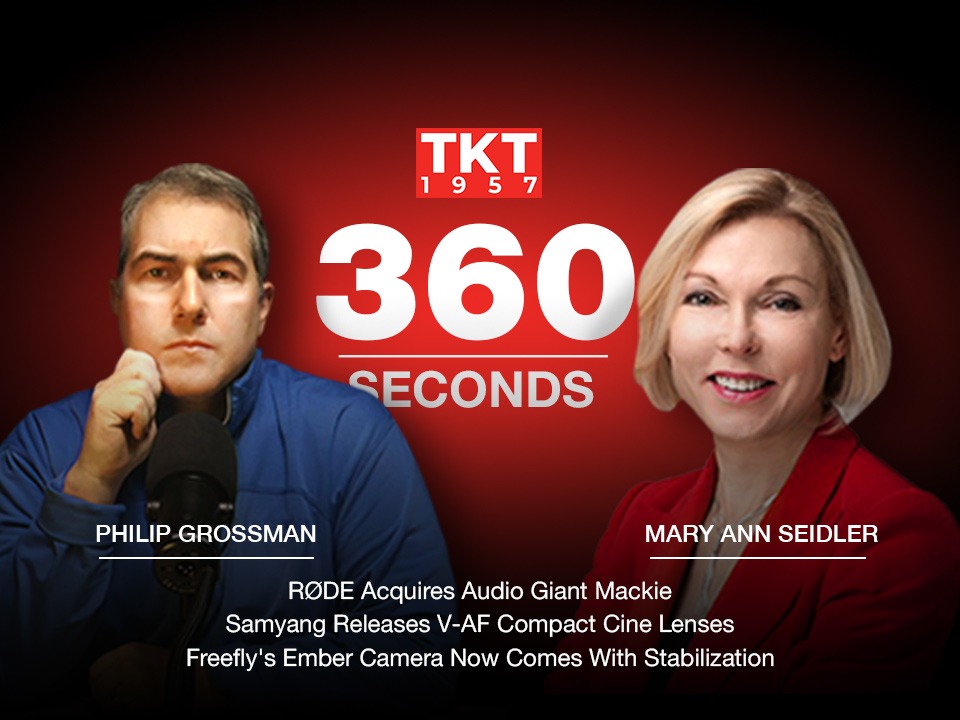
-
Samyang Releases V-AF Compact Cine Lenses
-
RØDE Acquires Audio Giant Mackie
-
Freefly’s Ember Camera Now Comes With Stabilization
The live broadcast of the program “360 Seconds. Broadcast News & Commentary” took place on December 11, 2023.
Hosts: Philip Grossman, host and co-producer at Visionaries; Mary Ann Seidler, owner of First Light Media and consultant for multiCAM Systems and Telos Alliance; and Maria Kholodova.
Maria: The newly released V-AF series features compact, auto-focus cine lenses optimized for up to 8K video, with a lightweight design ideal for gimbal/drone use and innovative Tally Lamps. The series ensures seamless lens changes and enhanced usability for solo creators and professionals alike. So Philip, can you unpack this for us?
Philip: Sure. There’s a growing trend of lens manufacturers producing what they label as cine lenses. Like anything else, the definition of a cine lens can vary. As I’m getting older, I appreciate that autofocus is awesome because manual focusing becomes more challenging. These lenses are particularly useful for drone use and are compatible with many cinema cameras that have built-in autofocus capabilities. I recently watched a review highlighting a common issue: photographic lenses versus cine lenses differ in the amount of ‘breathing’—a zooming effect that occurs when you adjust the focus. These lenses seem to have minimal breathing, which is impressive. Moreover, they are surprisingly affordable. They’re ideal for both novice filmmakers and professionals using gimbals. The compact lenses are color-matched, ensuring consistency regardless of which lens is mounted on the camera. I think they’re fantastic, and I might even purchase one or two myself. The fact that they have functional autofocus and adjustable settings on the lens is intriguing. I hope to see more manufacturers adopting autofocus in cinema lenses.
Maria: Big Audio news today, RØDE has officially acquired Mackie, a renowned audio mixer company. This strategic move expands The Freedman Group’s reach in the pro audio market, integrating Mackie’s innovation and expertise into RØDE’s diverse product line. The merger aims to leverage both companies’ strengths while preserving Mackie’s distinct brand identity. So So, Mary, can you talk to us about this?
Mary: This is really interesting because RØDE started out as a mic manufacturer, but then they introduced a real game-changer: the RØDECaster. Ever since, everyone else in the audio industry has been playing catch-up. Mackie has always been the go-to for external mixers, especially in the radio industry where the common advice was just to get a little Mackie. They have many products that are somewhat similar. I’ll be really curious to see if they take the Berkshire pathway approach, which would be great. This approach would let Mackie do what they know best without interference, potentially giving them a boost to diversify their product line. I wonder if they might streamline some products, as both companies make mic stands and similar accessories. It would be exciting to see Mackie come out with new processors and other innovations. I’m super excited about this. RØDE has quickly devoured its competition, which is remarkable.
Philip: I have a question. Do you see this as creating a sort of Lexus-Toyota model? My first mixer ever was a Mackie. You mentioned buying a little Mackie; they’re great little mixers and were seen as reliable for live shows. Meanwhile, RØDE was more of a young upstart. Do you think they’ll merge the two companies’ identities, or will they keep them distinct? Will they just brand everything as RØDE-Mackie?
Mary: What I’m hoping to see is that RØDE will provide the capital and perhaps even engineering support to encourage Mackie to explore different directions. As cool as the RØDECaster is, Mackie has smaller mixers that fit into various market niches where RØDE may not want to venture. So, you’re right. It would be best for everyone if we saw something akin to a Lexus-Toyota model, allowing both companies to thrive and explore different paths.
Maria: Perfect. All right, Freefly has updated its high-speed Ember camera, introducing post-capture stabilization in the Ember app. This feature, requiring firmware and app updates, offers customizable stabilization with an accompanying image crop. So, Philip, can you talk to us about this really quickly?
Philip: Yes. This Ember camera is quite a unique, niche product. It’s a high-speed camera capable of 400 and 600 frames per second. Adding post-capture stabilization is an interesting move. Initially, I was skeptical because it’s post stabilization, meaning they’re just capturing raw data off the sensor. However, this approach does make sense, as it can provide unique perspectives not previously possible with high-speed cameras. Typically, high-speed cameras have always been used on tripods; you don’t really move them around. But now, this feature allows for some handheld applications. It will be fascinating to see how this camera is used in the broadcast and cinema markets. Alright, great.
Maria: That’s all the time we have today. Many thanks to our expert – Philip and Mary. And don’t forget to comment on the news we’ve discussed. See you next Monday at the same time!
Production – TKT1957 LLC.
Media Partner – Cine Gear Expo.
360 Seconds. Broadcast News & Commentary
The weekly show, focusing on the latest products and solutions in the global TV and film industry, features insights and analysis from top experts. Released every Monday within the TKT1957 network, the program can be found on the YouTube channel, social media groups, and the tkt1957.com website. Engage with the content, view the episodes, and participate in the conversation by leaving your questions in the comments section!
The program can be watched every Monday at 20:00 UTC+4 by clicking on any of these links:









